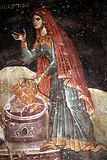

| Previous day | Next day |
| Old Style
March 20
|
Thursday |
New Style
April 2
|
|
5th Week of Great Lent.
Tone 8.
Great Lent. |
Wine and oil allowed.
|
![]() The Holy Fathers who were slain at the Monastery of St. Sabbas: Sts. John, Sergius, Patrick, and others (796).
The Holy Fathers who were slain at the Monastery of St. Sabbas: Sts. John, Sergius, Patrick, and others (796).
Martyrs Photina (Svetlana), the Samaritan woman; her sisters Phota, Photis, Parasceva, and Cyriaca; her sons Victor (or Photinus) and Joses; and Sebastian the Duke, the officer Anatolius, and Theoclitus, the former sorcerer—all martyred under Nero (ca. 66). Seven Virginmartyrs of Amisus (Samsun): Alexandra, Claudia, Euphrasia, Matrona, Juliana, Euphemia, and Theodosia (310). St. Nicetas the Confessor, bishop of Apollonias in Bithynia (9th c.). Suffering of St. Euphrosynus of Blue-Jay Lake (Novgorod) (1612).
Righteous Abel, first martyr in the history of mankind. St. Martin of Braga in Iberia (580). St. Cuthbert of Lindisfarne, bishop (687). St. Herbert of Derwentwater, priest and hermit (687). Hieromartyr Tadros, bishop of Edessa, at Jerusalem (691). Martyr Michael the Sabbaite, at Jerusalem (691). St. Wulfram, missionary (Neth.) (703). Martyr Archil II, king of Georgia (744). New Martyr Myron of Mega Castro on Crete (1793). New Hieromartyr Nicholas Holz, priest, of Novosiolki (Chelm and Podlasie, Poland) (1944).
Thoughts for Each Day of the Year
According to the Daily Church Readings from the Word of God
By St. Theophan the Recluse

Thursday.
A haughty spirit goeth before a fall (Prov. 16:18).[1] Therefore, do not allow evil thoughts to come in, and there will be no falls. And yet what are people most careless about? About their thoughts. They allow them to seethe as much and however they like, not even thinking to subdue them, or to direct them to rational pursuits. Meanwhile, within this inner turmoil the enemy approaches, places evil in the heart, seduces it and inclines it toward evil. And the person unnoticeably prepares himself for evil. It remains for him to either carry out the evil fixed to his heart, or to struggle with it. But this is our sorrow: that almost nobody takes on the struggle; while all are led to the evil as if bound.
[1] The Slavonic for Prov. 16:18 reads: Evil thoughts go before a fall. Probably St. Theophan used the Slavonic version as he wrote, but the editor used the Russian version, and so the editor added the words, “evil thoughts” in parentheses in my version of the text).
Articles
 Martyred Holy Fathers who were slain at the Monastery of St SabbasSaints John, Sergius, Patrick and others were slain in the Monastery of Saint Sabbas. |
 Martyr Kyriake of RomeSaint Kyriake was the sister of the Holy Martyr Photina (Svetlana) the Samaritan Woman, with whom the Savior conversed at Jacob’s Well (John. 4:5-42). |
 Martyr Archil II the King of GeorgiaThe Holy Martyr Archil II, King of Georgia belonged to the dynasty of the Chosroidoi, and he was a direct descendant of the holy emperor St Mirian (+ 342). |








